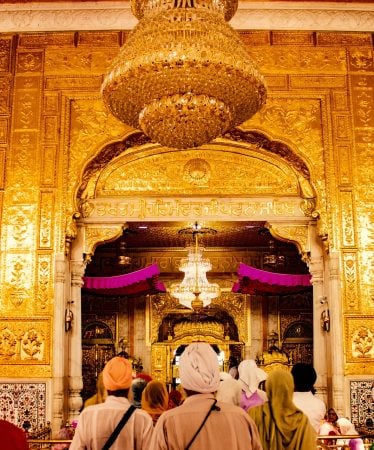
The first Gurdwara, or Sikh temple, was established by Guru Nanak, the first Sikh Guru, at Kartarpur in 1522. It was named Dharamsala (“Inn of the Dharma”). After that, wherever Guru Nanak taught and fed the sadhus, those places also became known as Dharamsalas.
In the Sikh way of life, the Gurdwara ceremony developed through the evolution of the teachings of the 10 Sikh Gurus. Guru Nanak Dev Ji gave Sikhs the Shabad Guru, and began the tradition of rising in the early morning to sing shabads in the company of the “Sadh Sangat,” the company of the holy.
Guru Angad Dev Ji, the second Sikh Guru, perfected the Gurmukhi script so that the hymns would be written down and preserved accurately.
Guru Amar Das Ji, the third Sikh Guru, wrote Anand Sahib, the Song of Bliss, which is played after the Gurbani Kirtan during a Sikh gurdwara service.
Guru Ram Das Ji, the fourth Sikh Guru, started the first system of worship at the site of the Golden Temple before it was actually completed. Guru Ram Das wrote the Lavaan, the Sikh Wedding Ceremony, performed in a Gurdwara for his own wedding to Bibi Bhani Ji. Asa Di Var, a shabad that describes the creation of the Universe and the Naam as that creative force, which has been practiced since the time of Guru Nanak.
Guru Arjan Dev Ji, the fifth Sikh Guru, compiled all the writings by the Gurus and Bhagats up until that time, and called it the “Adi Granth.” He installed the Adi Granth inside the Golden Temple.
Guru Gobind Singh Ji, the tenth Sikh Guru, gave us Ardas. The Ardas is the prayer of the Sikh congregation, the Sadh Sangat, channeled through the spoken prayer of one individual who recites the Ardas aloud.
Then after Ardas, Sikhs sit down to hear the Hukam, or the direction of the Guru, given in response to this group prayer.
Guru Nanak gave Sikhs the formula for the preparation and serving of Gurprasad, a delicious sweet of cooked butter, flour and sugar or honey, that is distributed at the end of every gurdwara program. The distribution of Gurprasad showers the blessings of the Guru on everyone equally.
~Resource: Living Reality (1994) by Bibiji Inderjit Kaur Khalsa.
Note: additional information about the 10 Gurus and the Shabad Guru has been shared in prior Sikh Dharma 101 lessons.

